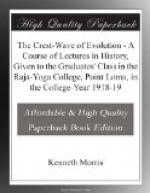First a few more items from Megasthenes as to India under Chandragupta. There was no slavery, he notes; all Indians were free, and not even were there aliens enslaved. Crime of any kind was rare; the people were thoroughly law-abiding. Thievery was so little known, that doors went unlocked at all times; there was no usury, and a general absence of litigation. They told the truth: as a Greek, he could not help noticing that. The men were exceptionally brave; the women, chaste and virturous. But “in contrast to the general simplicity of their style, they loved finery and ornaments. Their robes were worked in gold, adorned with precious stones, and they wore flowered garments of the finest muslin. Attendants walking behind held umbrellas over them....”
The system of government was very highly and minutely evolved. “Of the great officers of state, some have charge of the markets, others of the city, others of the soldiers; others superintend the canals, and measure the land, or collect the taxes; some construct roads and set up pillars to show the by-roads and distances from place to place. Those who have charge of the city are divided into six boards of five members apiece: The first looks after industrial art. The second attends to the entertainment of strangers, taking care of them, sound or sick, and in the event of their death, burying them and sending their property to their relatives.” The third board registered births and deaths; the fourth, fifth and sixth had supervision of things commercial. Military affairs were as closely organized: there were Boards of Infantry, Cavalry, War Chariots, Elephants, Navy, and Bullock Transport. And behind all these stood Chandragupta himself, the superman, ruthless and terrifically efficient; and Chanakya, his Macchiavellian minister: a combination to hurry the world into greatness. And so indeed they did.




